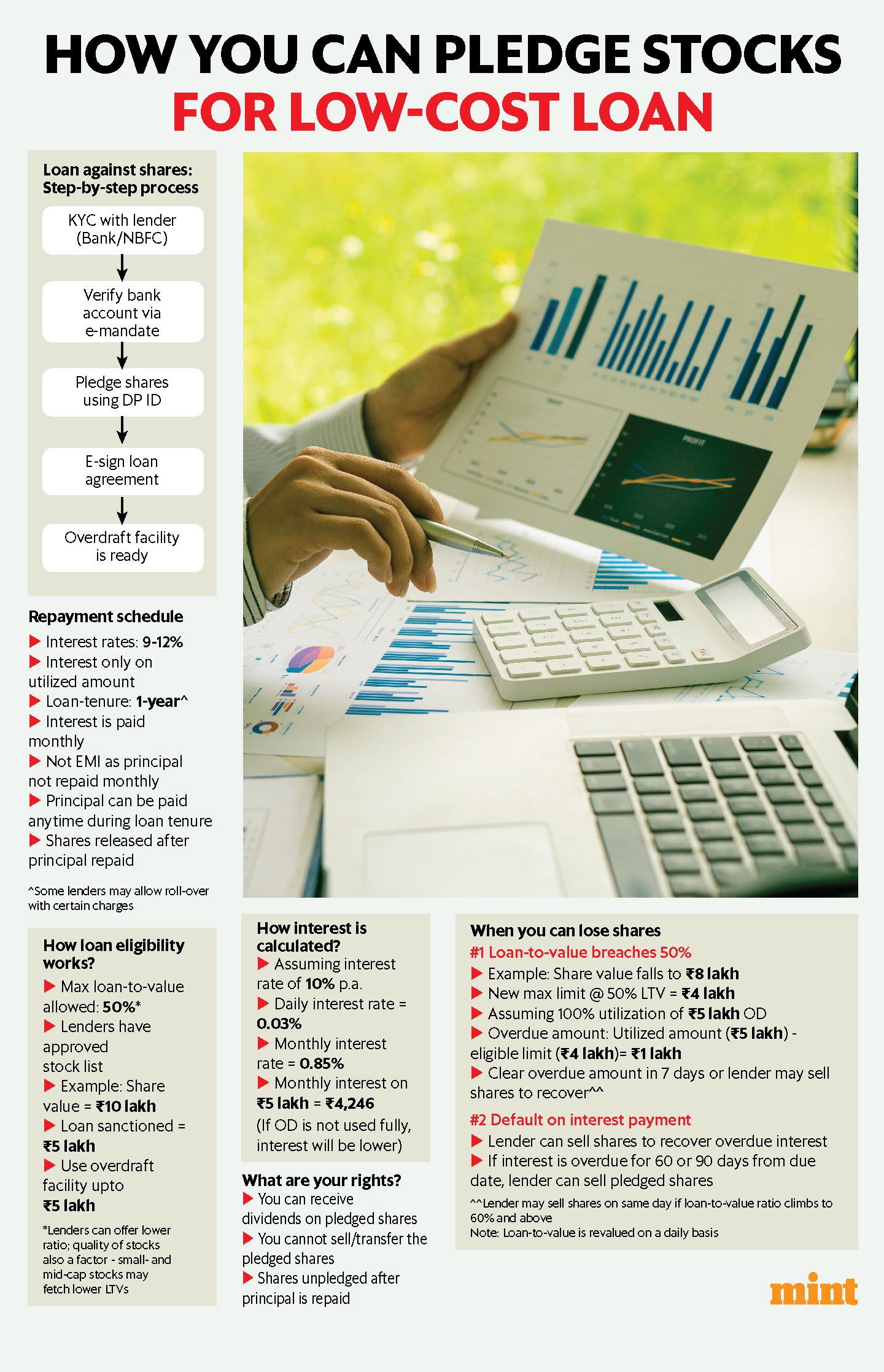However, leveraging shares comes with conditions and risks that need careful consideration.
How loan against shares works
A loan against shares (LAS) allows borrowers to pledge their equity holdings as collateral for an overdraft facility, offering flexibility by charging interest only on the utilized amount.
For example, if shares worth ₹10 lakh are pledged, the borrower can access up to ₹5 lakh, following the Reserve Bank of India’s (RBI) maximum loan-to-value (LTV) ratio of 50%. However, lenders may apply stricter limits. For mid-cap or small-cap stocks, the LTV can drop to 30%.
Read this | How you can get a loan against mutual funds instead of breaking the investment when you need cash
The RBI mandates that the LTV ratio for LAS must be capped at 50%. If the value of the pledged shares declines, raising the LTV beyond this threshold, borrowers have two options:
- Reduce the loan amount to restore the LTV to 50%.
- Pledge additional shares to increase the equity cover.
For instance, if a borrower utilizes the full ₹5 lakh overdraft facility against shares initially worth ₹10 lakh, and the share value drops to ₹8 lakh, the LTV breaches the 50% mark. To restore it, the borrower must either reduce the loan amount to ₹4 lakh or pledge another ₹2 lakh worth of shares to maintain coverage. The LTV revaluation occurs on a daily basis.
The LTV ratio varies depending on the quality of the pledged shares. “There is a range of loan to value ratio offered by different lenders. Typically, for large-cap stocks the borrower can get the highest permissible loan-to-value, which is 50%. For small- and mid-cap stocks it could go down to as low as 30%,” explains Ravi Doshi, business head-secured loans at Mirae Asset Financial Services (India).
Mirae Asset maintains a base LTV of 45% to keep an additional buffer, adjusting further based on stock quality. While the RBI’s 50% is the upper limit, lenders may impose tighter restrictions to mitigate risks.
It’s important to note that not all shares qualify for LAS. Each lender maintains a list of approved stocks, and only shares on this list can be pledged as collateral.

View Full Image
Repayment schedule
Loans against shares typically have a tenure of one year, with some lenders offering the option to roll over the loan for certain fees. Unlike traditional loans, LAS does not require monthly EMI payments that combine principal and interest. Instead, borrowers only need to pay the outstanding interest on a monthly basis.
For example, if you borrow ₹5 lakh at an annual interest rate of 10%, the daily interest rate would be approximately 0.03%, translating to a monthly interest rate of 0.85%. This means your monthly interest payment would amount to around ₹4,246.
Once the principal is fully repaid, the pledged shares are released, and no further interest accrues.
Read this | Here’s everything you need to know about the RBI’s Liberalised Remittance Scheme
Since LAS functions as an overdraft facility, interest is charged only on the amount utilized, offering borrowers added flexibility. Most lenders charge interest rates between 9-12%.
Can you lose your shares?
Yes, there are scenarios where you risk losing your shares if certain conditions are not met:
Failure to restore LTV ratio within seven days: If the loan-to-value (LTV) ratio exceeds 50% (or the lender’s specified threshold) and is not restored within the seven-day window, the lender can seize and sell your shares to recover the overdue amount.
For example, let’s say the pledged shares initially valued at ₹10 lakh drop to ₹8 lakh, reducing the eligible loan limit to ₹4 lakh. If the borrower has already drawn ₹5 lakh, the excess ₹1 lakh becomes overdue. If the borrower fails to reduce the loan or pledge more shares within seven days, the lender can sell shares worth ₹1 lakh to cover the shortfall.
Immediate liquidation at higher LTV breaches: If the LTV reaches 60% or higher, the lender can liquidate the shares immediately, without waiting for the seven-day grace period.
Non-payment of interest: Lenders may also sell the pledged shares if the borrower fails to pay interest for 60-90 days from the due date, depending on the loan terms offered by the lender.
When to use
A loan against shares can be a useful option during emergencies or unexpected expenses.
“We have seen clients using it for medical emergencies, or to even bring down other high-cost loans,” says Vinayak Savanur, a Sebi-registered investment advisor at Sukhanidhi Investment Advisors.
He shared an example of a client who swapped a high-interest personal loan with LAS, benefiting from lower interest rates and greater repayment flexibility.
Also read | How to turn stock market losses into tax savings
While LAS offers low-interest borrowing and repayment flexibility, it remains a liability. It should be used only when there is a genuine financial need, as there is always a risk of losing your shares. Borrowers should be cautious and ensure they take only what is needed for short durations, keeping the loan-to-value ratio well within the limits set by the lender.
